2022 Volume 62 Issue 5 Pages 1004-1012
2022 Volume 62 Issue 5 Pages 1004-1012
Stress relaxation, which occurs during holding at the bottom dead center in press forming, affects press formability. Because holding at the bottom dead center is completed within several seconds, it is important to predict the stress relaxation behavior of the first few seconds after the start of holding. The purpose of this study is to propose a model, the material parameters of which are obtained from tensile tests, to predict the stress decreasing behavior in the early stage of stress relaxation in steel sheets. We constructed the model by modifying the Kocks-Mecking model based on the following assumptions: Stress relaxation at room temperature is due to the slip motion of dislocations, which indicates that the plastic strain rates at the start of stress relaxation are same as those in the previous tensile process. In this study, it was assumed that the change in microstructure during stress relaxation is negligible; hence material parameters remain constant during stress relaxation. The measured and predicted stress relaxation behaviors for various strain rates during the tensile process were compared. It was observed that an increase in the plastic strain rate during the tensile process accelerated stress relaxation. The proposed model was able to predict this phenomenon. However, the relative error between experimental results and the model increased as the stress relaxation progressed mainly owing to dynamic strain aging. Therefore, the proposed model is applicable in the condition when effect of dynamic strain aging is negligible.
High strength steels have difficulties in press formability. Some studies reported that stress relaxation, which refers to decrease in stress when a material is subjected to a predetermined strain and sustained at the strain, affects press formability.1,2,3,4) This could lead to avoid difficulties in press-forming by suppressing springback1,2) or improving total elongation.4) The bottom dead center of press forming, where stress relaxation is considered to occur, is sustained within a few seconds. Therefore, understanding stress relaxation behavior in the first few seconds after the start of holding at the bottom dead center is important.
A recent study reported that an increase in the plastic strain rate during the tensile process accelerates stress decrease during stress relaxation especially in the first few seconds from stress relaxation beginning.5) Therefore, a model which predicts stress relaxation must be proposed with incorporating such effects of strain rate during tensile process on stress relaxation behavior.
Models to describe stress relaxation behavior have been proposed by early studies.6,7,8) Recently, a modified model, which is known as the logarithmic law, including the effect of change in athermal stress and mobile dislocation density during stress relaxation is proposed.9,10) The models provided in the abovementioned studies are used to calculate the material structure factors (athermal stress, dislocation density, and activation volume) by fitting the models to stress relaxation behavior in the late stage of the stress relaxation test. However, the stress relaxation behavior described by these models6,7,8,9,10) in the early stage of stress relaxation test cannot be expressed. This is because a variable with time dimension in the models6,7,8,9,10) is shifted to a late time, and then fitted to the stress relaxation behavior. Therefore, a new model must be proposed to predict stress relaxation behavior in the early stages of stress relaxation.
Both plastic deformation and stress relaxation at room temperature are due to the same mechanism: slip motion of the dislocation rate-determined by thermal activated process. Therefore, to propose a model to predict stress relaxation behavior in the early stage of stress relaxation, we focus on the Kocks-Mecking (KM) model,11) which describes the stress-strain relationship based on the thermally activated process of dislocation slip. This model is expected to describe uniformly stress and time relationship during both tensile deformation and stress relaxation. Therefore applying the KM model will achieve an improvement in prediction of stress relaxation behavior comparing with the conventional logarithmic law model.
In this study, the followings were assumed to predict the stress relaxation behavior by modifying the KM model: First, we hypothesized that the motion of the dislocation during the tensile process continues ever immediately after the start of stress relaxation. This hypothesis gives the following assumption based on Orowan’s equation,12) where the product of the mobile dislocation density and the dislocation velocity is proportional to the plastic strain rate, i.e.,
Assumption 1: The plastic strain rate at the start of the stress relaxation is the same as that in the previous tensile process.
It is generally known that the dislocation microstructure recovers,13,14) mobile dislocation density decreases15) and dislocations are accumulated by plastic deformation during stress relaxation.16) However, we assume the following based on considering that the effect of change in the dislocation microstructure on stress relaxation behavior is negligible in the early stage of stress relaxation to simplify the model, likely with early studies.6,7,8,17)
Assumption 2: The material constants on the dislocation microstructure are obtained from tensile tests and the material constants are unchanged during stress relaxation.
The objective of this study is to predict stress relaxation behavior in the early stage of stress relaxation in steel sheets. Therefore we estimate the stress relaxation behavior based on the above assumptions and confirm whether stress decrease during stress relaxation is accelerated by increase in plastic strain rate during tensile process, which is characteristic behavior in the early stage of stress relaxation. We also calculate the error between estimated and experimentally obtained stress relaxation behavior and discuss the applicable condition of the model to validate accuracy of the model.
It is known that stress relaxation at room temperature is due to the slip motion of mobile dislocations.6,7) The motion of dislocations is rate-determined via thermally activated process. Therefore, we conceive that the model based on the thermally activated process of dislocation motion can describe the stress relaxation behavior. We focus on the KM model,11) which is a model that describes the stress-strain relationship based on the thermally activated process of dislocation motion.
This section provides an outline of the KM model. On the basis of the mechanism on thermally activated process of dislocation motion, the interaction between dislocation motion and defects can be categorized into long-range and short-range obstacles. Long-range obstacles, of which the thermally activated process does not affect dislocation overcoming, include the elastic strain fields of other dislocations, the back stress due to curvature of the glide dislocation,18) and grain boundaries.19) Short-range obstacles, in which the thermally activated process assists dislocation overcoming, include the Peierls potential, interactions with forest dislocations, the motion of jogs and overcoming interstitial atoms or precipitates.20) This idea expresses the flow stress σ as
| (1) |
| (2) |
| (3) |
| (4) |
One of the general forms of the expression is known as the KM model
| (5) |
| (6) |
| (7) |
As explained in Section 2.1, the original KM model is applied to describe the stress-strain relationship by obtaining the material parameters from fitting the model to the stress-strain relationships derived from tensile tests. Namely, giving a plastic strain εp, plastic strain rate
This paragraph summarizes the approach for modifying the KM model. First, by replacing the plastic strain rate
The detailed procedure for modifying the KM model is as follows. The first step is to replace the plastic strain rate
| (8) |
| (9) |
| (10) |
| (11) |
| (12) |

Determination of parameter related to rigidity of tensile testing machine M from stress-strain relationship during stress relaxation process.
Substituting Eq. (12) into Eq. (5) yields
| (13) |
We numerically obtained the approximate solutions for the differential equation shown in Eq. (13). Substituting an initial condition comprising the plastic strain εp and its rate
| (14) |
Although it was reported that recovery13,14) and accumulation of dislocation by plastic deformation16) occurred during stress relaxation, and models that accounted for microstructure changes have been proposed,9,10) we assume that the microstructure changes are negligible during stress relaxation process. Namely, the parameters of the microstructure, i.e., the athermal stress σa, normalized activation energies g0I and g0D; frequency factors
A hot rolled steel sheet mainly containing 0.08C-1.7Si-1.2Mn (mass%) was used.21) Table 1 shows the mechanical properties of the sample. Figure 2 shows the optical microscopic image of the sample. The surfaces were etched with a nital solution after mirror polishing. The material consisted of ferrite (white region) and bainite (black region). The area fraction of bainite was 13.2%. The average diameter of ferrite grains was 7.08 μm.
| Yield strength (MPa) | Tensile strength (MPa) | Total elongation (%) |
|---|---|---|
| 478 | 591 | 29 |

Optical micrograph of the sample etched with a nital solution. The sample consists of ferrite (white region) and bainite (black region).
To calculate the parameters of the KM model, tensile tests were performed under the following conditions: First, we performed tensile tests with strain rates of 6.0 × 10−6, 6.0 × 10−5, 6.0 × 10−4, 6.0 × 10−3 and 6.0 × 10−2 s−1 at 293 K. Furthermore, we performed tensile tests at a strain rate of 6.0 × 10−4 s−1 at temperatures of 223 and 373 K. Dimensions of the specimens are shown in Fig. 3. The specimen shown in Fig. 3(a) was used in tensile tests at 293 and 373 K and the specimen shown in Fig. 3(b) was in 223 K. The effect of stress concentration due to the pin holes in Fig. 3(b) was negligible (see appendix). A tensile testing machine (AG-I 250 kN, Shimazu Corp.) and video extensometer (DVE-101, Shimazu Corp.) were used in tests at 293 and 373 K, and tensile testing machine (AG-X 250 kN) and extensometer (3541-010M-040M-LT, Epsilon Technology Corp.) were used at 223 K for loading and measuring strain. The test at 373 K was performed in a thermostatic chamber (TCE-N300, Shimazu Corp.) and at 223 K was in dry ice-alcohol.
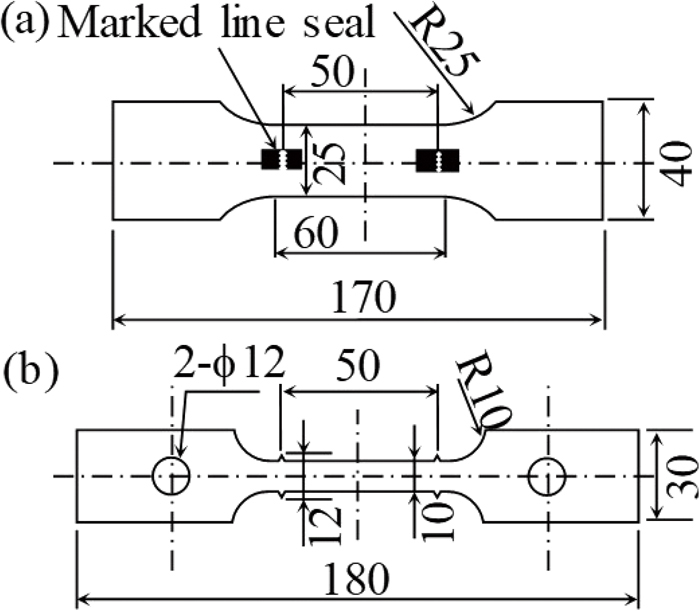
Specimen dimensions. Used at (a) 293 and 373 K, and (b) 223 K. Thickness = 3.2 mm. Unit: mm.
We determined the material parameters of the KM model based on the results of the tensile tests described above. To calculate the athermal stress σa, we obtained the relationships between the functions of the experimental condition, i.e., the plastic strain rate
Next, to calculate the material parameters related to the interstitial hardening: threshold stress
Finally, to calculate the material parameters related to deformation hardening, threshold stress
To obtain the stress relaxation behavior, we performed crosshead holding tests under the following conditions. The specimen shown in Fig. 3(a) was used. Tensile processes in which the specimen was tensile deformed were performed until the total strain of the specimen reached 0.050, followed by a stress relaxation process in which the crosshead was sustained for a predetermined duration. The strain rates for the tensile process were 6.0 × 10−6, 6.0 × 10−4, 6.0 × 10−3 and 6.0 × 10−2 s−1 at 293 K. The duration in which the crosshead was sustained was 39600 s (at the test condition in which the strain rate during the tensile process was 6.0 × 10−3 s−1) and 30 s (under the other test conditions). Experimental equipment is same with tensile tests explained in Sec. 3.2.
Note that the procedure of the crosshead holding test was differ from a standard of stress relaxation test, ASTM E328-13. The standard recommends to reduce the total strain of the specimen during stress relaxation tests so as to suppress the increase in the total strain due to the elastic deformation of the tensile testing machine when performing the stress relaxation test with a constant crosshead displacement. However, when the total strain is reduced, it becomes difficult to separate whether the stress reduction during the stress relaxation test is due to the stress relaxation phenomenon or elastic unloading corresponding to reduction in total strain. In order to avoid this problem, the crosshead displacement was maintained to be constant in this study.
Figure 4 shows the stress-strain curves obtained from the tensile test at the strain rates of 6.0 × 10−6, 6.0 ×10−5, 6.0 × 10−4, 6.0 × 10−3 and 6.0 × 10−2 s−1 for the temperature of 293 K and at 6.0 × 10−4 s−1 for the temperature of 223 and 373 K . The increase in strain rate or decrease in temperature increase the flow stress. In the following sections, we determined the parameters of the KM model based on the stress-strain curves.

Effects of strain rate and temperature on stress-strain relationship obtained from tensile tests.
Figure 5 shows the relationship between the LM parameter ξ and flow stress σ. The flow stress was plotted for each 0.02 plastic strain. The true stress σ at ξ−1 = 0 obtained via linear regressions was determined as athermal stress; σa = 562(0.002 + εp)0.0742. The increase of the athermal stress with plastic strain has been observed in some kinds of steels.27) due to increase in dislocation density by plastic deformation.16,23)
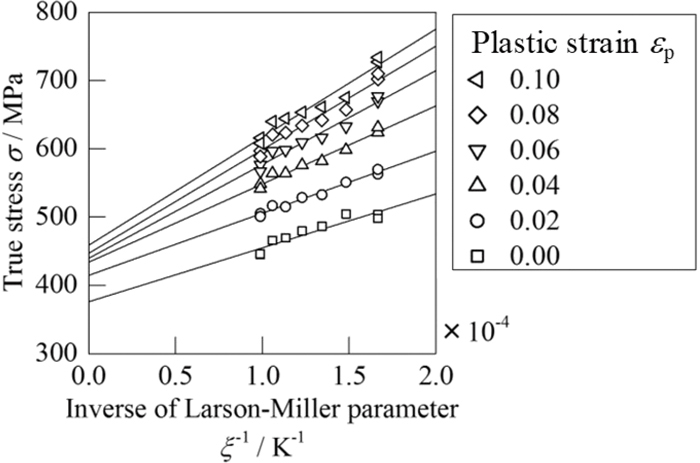
Linear regression between Larson-Miller parameter and flow stress at each plastic strain in tensile tests.
Figure 6 shows the relationship between

Determination of material parameters related to interstitial hardening. The function of yield strength (
Figure 7 shows the relationship between
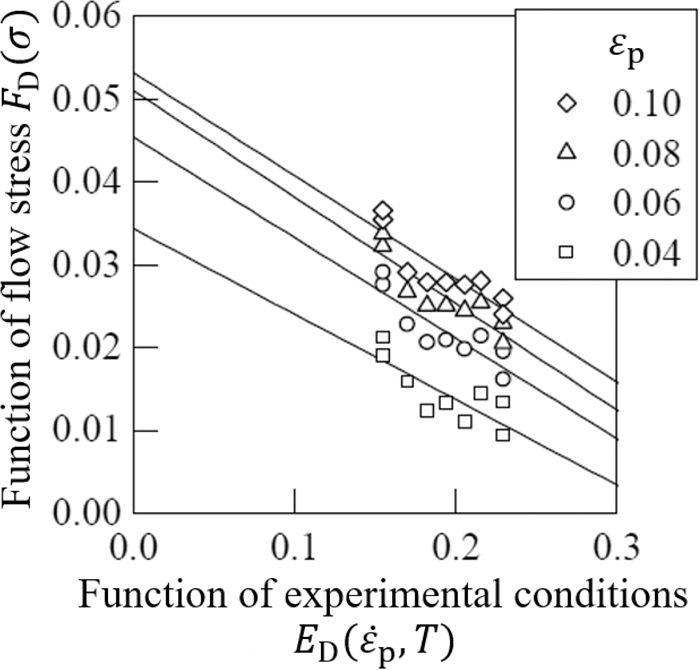
Determination of material parameters related to deformation hardening. The functions of flow stress (FD(σ), σ is flow stress at each plastic strain εp) obtained from tensile tests are arranged with function of tensile test conditions (ED(
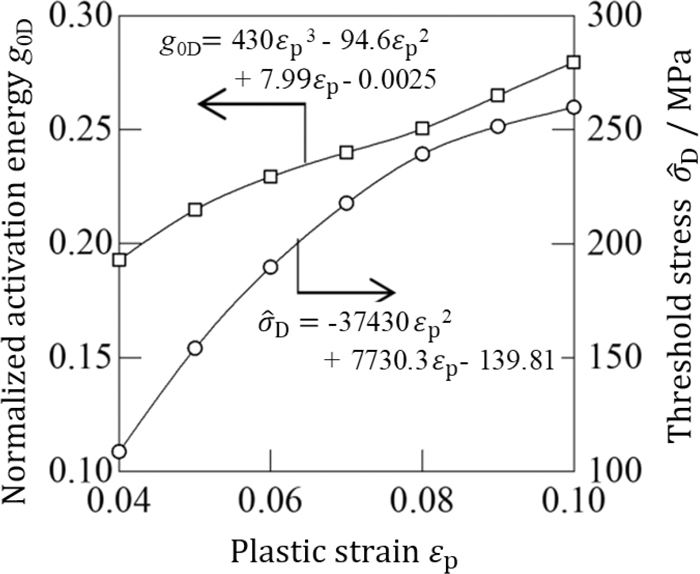
Change in normalized activation energy g0D and threshold stress
Figure 9 shows the change in the total, plastic, and elastic strains (Fig. 9(a)) and their rates (Fig. 9(b)), obtained from the crosshead holding tests and predicted by the KM model. During the tensile process, the increase in the total strain increases the stress σ (Fig. 9(a) blue line) and plastic strain εp (Fig. 9(a) red line). This behavior has been expressed by the original KM model based on Eq. (5).22,23,24) During stress relaxation process, the stress σ decreases with time elapsing (Fig. 9(a) blue line). The plastic strain rate

Flow stress, total strain, plastic strain, and their rates obtained from crosshead holding tests and predicted by KM model when strain rate during tensile process was 6.0 × 10−3 s−1. (a) Elastic, plastic, and total strains. (b) Elastic, plastic, and total strain rates.
Figure 10 shows the measured and predicted results of the crosshead holding test during stress relaxation for various plastic strain rates
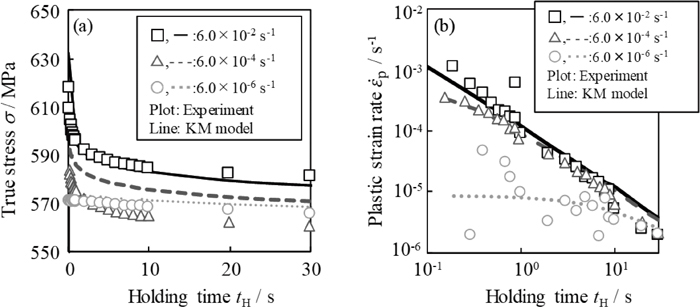
Effect of strain rate during tensile process on change in (a) stress and (b) plastic strain rate during stress relaxation obtained from crosshead holding tests and predicted by KM model.
To discuss the accuracy of the prediction, we compared the error between the measured and estimated stress relaxation behaviors of the KM model with the logarithmic law.9) The logarithmic law expresses the stress relaxation behavior as follows:
| (15) |
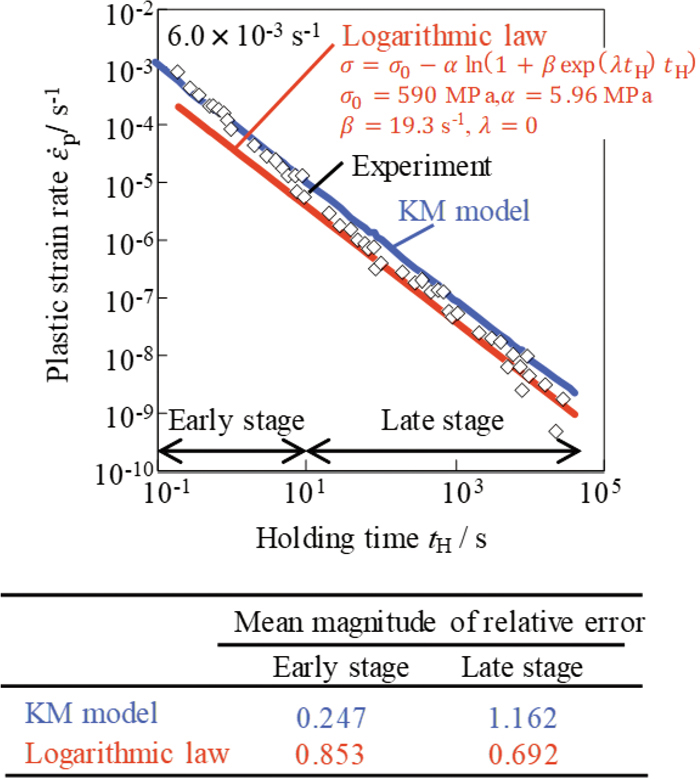
Stress relaxation behaviors obtained from crosshead holding tests and predicted by KM model and mean magnitude of relative errors between KM model or logarithmic law and measured data obtained from the crosshead holding test when strain rate during tensile process was 6.0 × 10−3 s−1.
Figure 10(b) shows that the plastic strain rate during stress relaxation is significantly affected by the plastic strain rate during the tensile process especially when the holding time is about within 10 s, which corresponds to the early stage depicted in Fig. 11. Therefore, it is possibly to say that the proposed KM model can describe the strain rate dependence of stress relaxation with higher accuracy than the logarithmic law during the early stage.
5.2. Applicable Conditions of Proposed ModelIn this section, it is discussed why the prediction accuracy during the early stage is higher than that during the late state when applying the KM model. Figure 12 shows the relationship between stress σ and holding time tH during the stress relaxation. The stress relaxation behavior predicted by the KM model is linear. However, the measured stress relaxation behavior shows a decrease in the slope around a holding time tH of 10 s, which corresponds to a sudden decrease in the magnitude of the stress rate
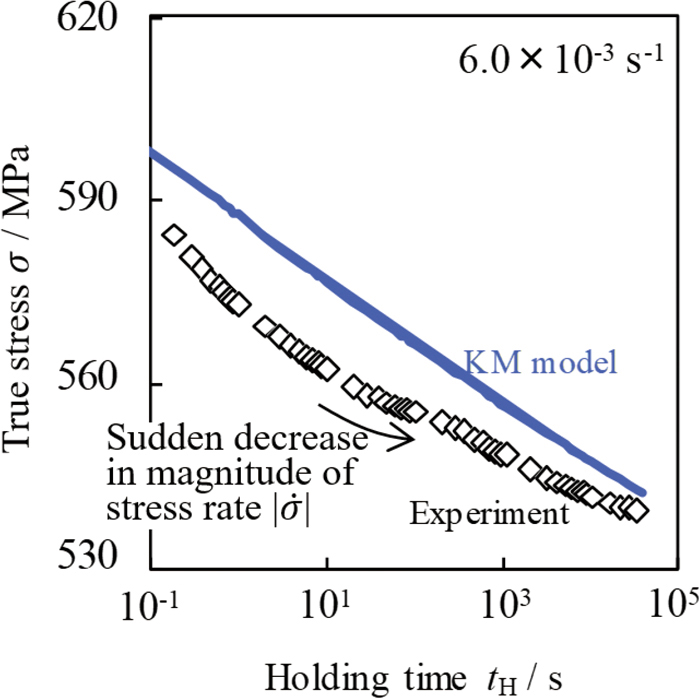
Stress relaxation behavior for holding time of 39600 s obtained from crosshead holding tests and predicted by KM model when strain rate during tensile process was 6.0×10−3 s−1.
The immobilization or disappearance of mobile dislocations are caused by interaction between dislocations and solute atoms (such as dynamic strain aging), and/or interaction among accumulated dislocations (such as pile-up to grain boundaries or second phase or annihilation of dislocations). However, we speculate that one of the main causes of the immobilization of mobile dislocations is dynamic strain aging through the following discussion. Figure 13 shows the ranges of temperature and plastic strain rate where dynamic strain aging by solute carbon occurs in ferrite.28) The plots in Fig. 13 show the plastic strain rate
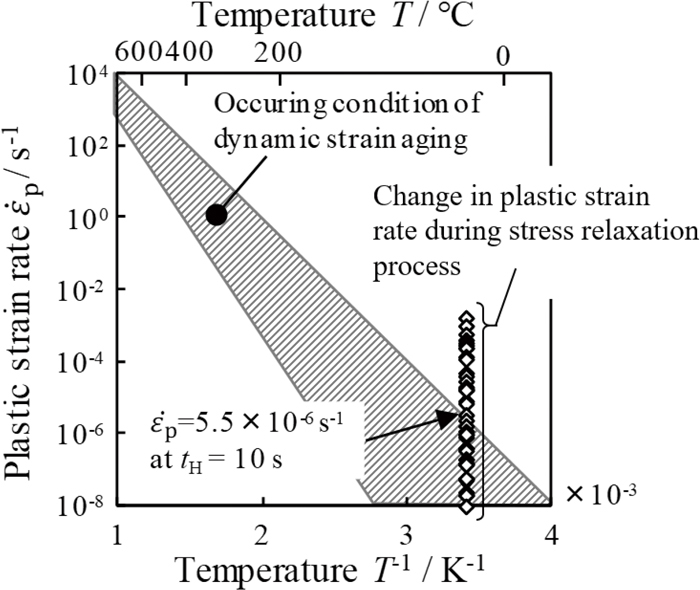
Ranges of temperature and plastic strain rate where dynamic strain aging by solute carbon occurs in ferrite.28) Plots are obtained from the crosshead holding test for holding time of 39600 s when strain rate during tensile process was 6.0×10−3 s−1.
The plastic strain rate
The original KM model has been applied for many kinds of metals of which elementally process is based on the thermally activated process of slip motion of mobile dislocations. Therefore the proposed KM model for prediction of stress relaxation behavior could be applied to metallic materials other than the steel sheet used in this study. Especially in metals including solute atoms, dynamic strain aging must be considered to increase prediction accuracy of stress relaxation behavior with the proposed KM model.
To predict the stress decreasing behavior during the early stage of stress relaxation, we proposed modifying the KM model, which is obtained based on the following assumptions. First, the initial condition, i.e., the plastic strain rate at the start of stress relaxation is the same as that during the tensile process. Second, the assumption that the material parameters, i.e., athermal stress σa, normalized activation energy g0, frequency factor
(1) The increase in the plastic strain rate during the tensile process accelerates the stress decrease during the early stage of stress relaxation. The proposed KM model is able to predict this phenomenon.
(2) The proposed KM model estimates stress relaxation behavior with high accuracy during the early stage of the stress relaxation than the logarithmic law. The condition in which the proposed KM model shows high accuracy corresponds to the condition where dynamic strain aging does not occur.
This study was supported by grants from the Amada Foundation (AF-2016032).
In general, the pin hole on tensile testing specimens may cause stress concentration and local deformation, which affect the results of tensile testing. However, we confirmed through the following finite element (FE) method that the stress concentration due to the pin hole shown in Fig. 3(b) does not affect the measurement of stress-strain relationship.
Figure A1 shows the model in the FE analysis. The dimension of the specimen was the same with that of Fig. 3(b). The specimen was modeled by solid elements. The stress-strain relationship measured by the tensile test at the strain rate of 6.0 × 10−3 s−1 (Fig. 4) was applied as the material properties of the specimen. Cylindrical rigid shell elements were arranged in the pin holes of the specimen. The one cylinder was full constraint. The displacement of another cylinder was moved in the longitudinal direction of the specimen with a speed of 1000 mm/s. The analysis was performed using LS-DYNA (version R11.1.0) with the dynamic explicit method. Then we calculated the true stress through the force opposed to the cylinder and the cross-sectional area at the center of the specimen. We also calculated plastic strain through the distance of the two nodes corresponding to the gauge length.
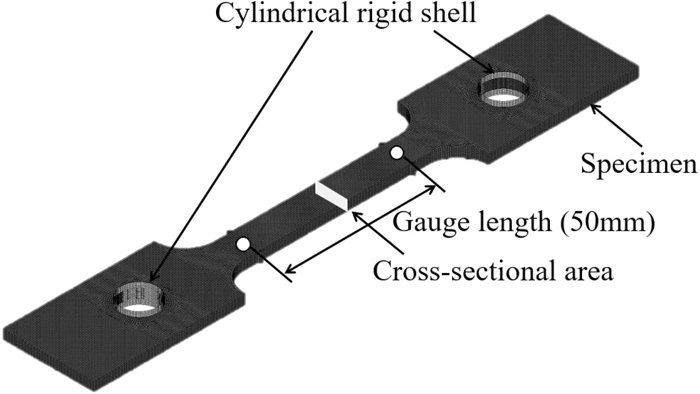
Model used in FE analysis. The dimension of the specimen was same with Fig. 3(b).
Figure A2 shows the relationship between plastic strain and true stress calculated with abovementioned analysis and measured with tensile testing at strain rate of 6.0 × 10−3 s−1. The calculated and measured stress-strain relationships were identical. Therefore, we conducted that the effect of stress concentration is negligible for measurement of stress-strain relationships.

Stress-strain relationships calculated with FE analysis and measured with tensile testing.